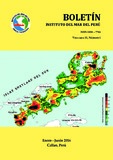Por favor, use este identificador para citar o enlazar este ítem:
https://hdl.handle.net/20.500.12958/3085Registro completo de metadatos
| Campo DC | Valor | Lengua/Idioma |
|---|---|---|
| dc.contributor.author | Vásquez Espinoza, Luis | |
| dc.contributor.author | Tenorio, José | |
| dc.date.accessioned | 2017-01-25T15:09:49Z | |
| dc.date.available | 2017-01-25T15:09:49Z | |
| dc.date.issued | 2016 | |
| dc.identifier.citation | Bol Inst Mar Perú 31(1), 2016: p. 105-113 | es_ES |
| dc.identifier.uri | https://hdl.handle.net/20.500.12958/3085 | |
| dc.description | Boletín IMARPE vol. 31, nº 1, 2016; p. 105-113 | es_ES |
| dc.description.abstract | Las condiciones físico-oceanográficas registradas son parte de un crucero de investigación de largo plazo para evaluar los cambios hidrográficos y biológicos en el estrecho de Bransfield y sus causas. Transectos oceanográficos históricos se realizan en los veranos australes de las expediciones ANTAR, ejecutados desde las islas Shetland del Sur hacia la península Antártica, con el fin de incluir a las importantes masas de agua y determinar su influencia sobre las aguas en el giro central del estrecho de Bransfield. Esta localidad mantiene características oceanográficas, donde interactúan tres tipos de aguas, las mismas que provienen de los mares de Weddell, Bellingshausen y del estrecho de Gerlache. También se caracteriza por la presencia del Frente Bransfield (FB), que desvía aguas cálidas y poco salinas de las aguas frías y salinas, las primeras fluyen hacia el noreste en la mitad septentrional y las segundas ocupan la mitad meridional del estrecho. El experimento realizado en la isla Elefante, señala que la variabilidad de la capa sub-superficial mantiene una variación cíclica, ascendiendo ligeramente durante el día, descendiendo en la noche, manteniendo el ambiente con una mayor columna de agua “cálida” comparado con el día. | es_ES |
| dc.description.abstract | ABSTRACT: Registered physical oceanographic conditions are part of a research cruise to assess longterm hydrographic and biological changes in the Bransfield Strait and its causes. Historical oceanographic transects are made in the austral summers Antar expeditions, run from the South Shetland Islands to the Antarctic Peninsula, in order to include major water bodies and determine their influence on the water in the central spin Strait Bransfield. Bransfield maintained oceanographic characteristics, where three types of water interact, the same coming from the Weddell, Bellingshausen and Gerlache Strait. It is also characterized by the presence of the Bransfield Front (FB), which deviates warm water and low salinity of cold water and salt, the first flow toward the northeast in the northern half and the second occupies the southern half of the strait. The experiment conducted on Elephant Island, indicates that the variability of the subsurface layer, maintains a cyclic variation, rising slightly during the day, dropping at night, keeping the night with a higher water column “warm” compared to day. | |
| dc.language.iso | spa | es_ES |
| dc.publisher | Callao | es_ES |
| dc.relation.ispartofseries | Boletín IMARPE;Vol. 31 n° 1, 2016 | |
| dc.rights | info:eu-repo/semantics/openAccess | es_ES |
| dc.rights.uri | https://creativecommons.org/licenses/by/4.0/ | |
| dc.source | Instituto del Mar del Perú - IMARPE | es_ES |
| dc.source.uri | Repositorio Digital IMARPE | es_ES |
| dc.subject | Estrecho De Bransfield | es_ES |
| dc.subject | Antártida | es_ES |
| dc.subject | Oceanografía Física | es_ES |
| dc.title | Condiciones físico-oceanográficas en la Expedición ANTAR XVII | es_ES |
| dc.title.alternative | Physical oceanographic conditions in the Expedition ANTAR XVII | es_ES |
| dc.type | info:eu-repo/semantics/article | es_ES |
| Aparece en las colecciones: | Boletín 31(1), 2016 | |
Ficheros en este ítem:
| Fichero | Descripción | Tamaño | Formato | |
|---|---|---|---|---|
| Boletin 31(1)-13.pdf | 3,85 MB | Adobe PDF |  Visualizar/Abrir |
Este ítem está sujeto a una licencia Creative Commons Licencia Creative Commons

